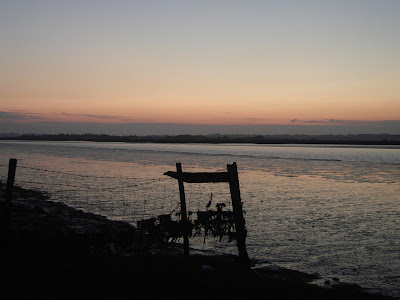It was nice and warm along the country park beach on Sunday 29th with a bit of colour and fragrance being provided by this burnet rose bush, pictured above. Missing from the beach over the last fortnight or so have been the sand martins. The colony in the sandy cliff was being used in the spring but it seems they've abandoned the area because of the wet and unsettled summer weather.
Looking at the cliff now, seemed to show about twenty nest-holes all with their entrances covered with spiders' webs, suggesting they've been abandoned for some time. One sand martin flew over the nearby fields with a handful of swallows.
On the park pond the little grebe chicks are still crying out to be fed while 6 teal and 10 mallard were the ducks present on Sunday. On the pools in the fields 8 black-tailed godwits and 10 lapwing were seen, while a little egret was also present. Two yellow wagtails flew over the car park during the day.
On the main mudflats in the morning 3 knot, 5 grey plover, 25 dunlin, 50 black-tailed godwits and 4 little egrets were the main birds of note here. A greenshank was heard calling in flight later in the day.
The previous week had been sunny and warm but came to an end when some thundery showers passed overhead on Sunday afternoon. This speckled wood butterfly pictured above was one of a handful seen about the park in the morning.
Amongst the variety of orangey / brown butterflies around the park was this single small copper pictured above. It kept low to the ground behind a hedge where it escaped the breeze. Other butterflies seen about the park were small / Essex skippers, large skipper, comma, hedge brown, meadow brown, small heath, small white and large white.
Also joining the butterflies as they fed on some of the flowers were ten six-spot burnet moths.
Several common blue damselflies were resting amongst the long grass and bushes out of the breeze. A few ruddy darters were seen while at the pond an emperor dragonfly and a four spotted chaser were patrolling their corners of the pond.
The moth trap operated on both Thursday and Saturday nights at the park with the former being the better session when 240 individuals of 36 species of macro moth were noted. By all accounts muggy conditions during Friday night proved ideal for moths according to several other Essex moth trappers but unfortunately the trap wasn't set up at the park that night.
This common emerald pictured above was one of three that turned up on Thursday night / Friday morning.
The distinctive peppered moth made another appearance at the trap, this pale one pictured being the commoner form seen at the park.
This well marked moth with bright white spots is probably the ear moth although the small group of ear moth species are difficult to tell apart without dissection to confirm the identity.
The moths that turned up on Saturday night included 22 species involving 70 individuals. Amongst these were a reed dagger, drinker, common carpet, garden carpet, least carpet, latticed heath, early thorn, dingy footman, common footman, scarce footman, buff ermine, lesser yellow underwing, brown-line bright eye, clay, common wainscot, uncertain, grey dagger, dusky sallow and snout.











































